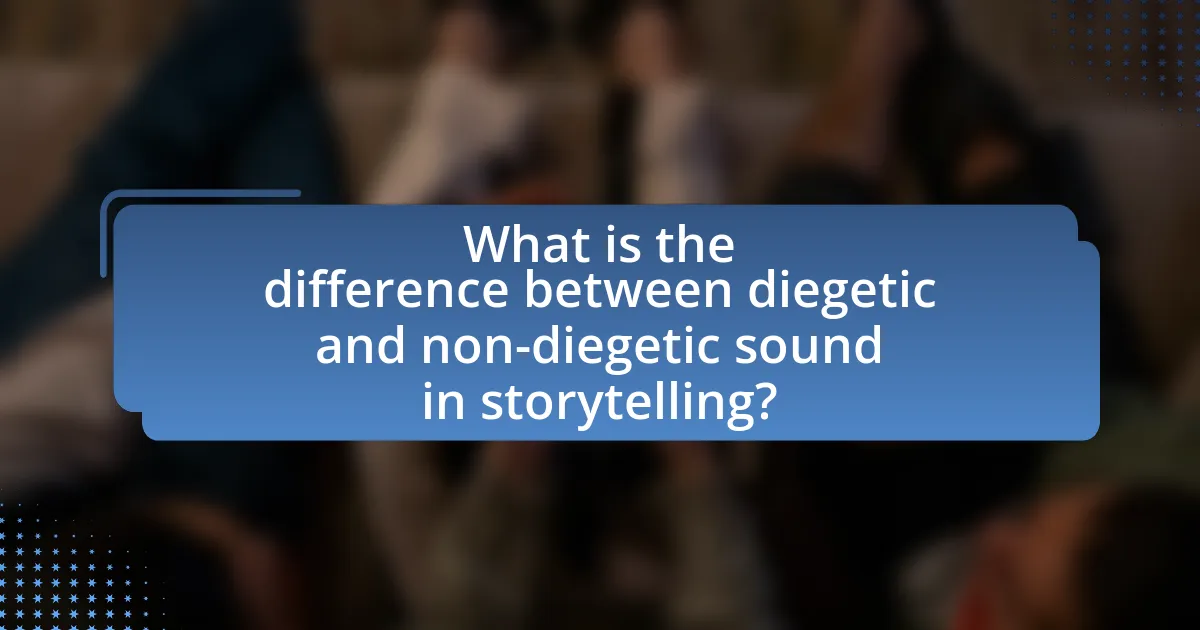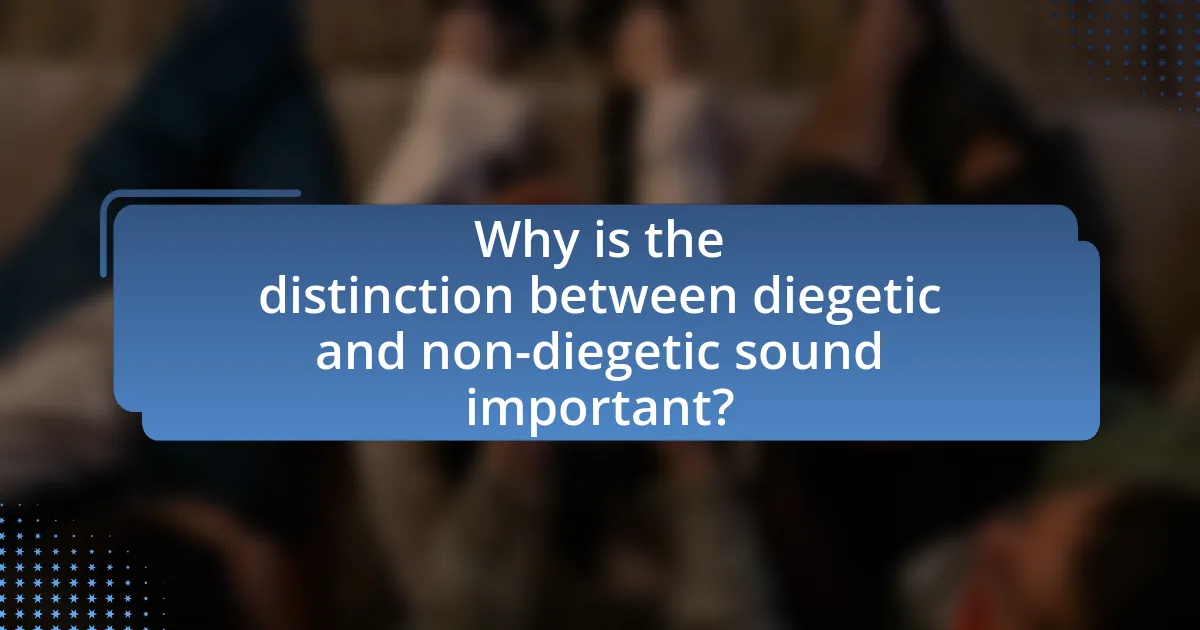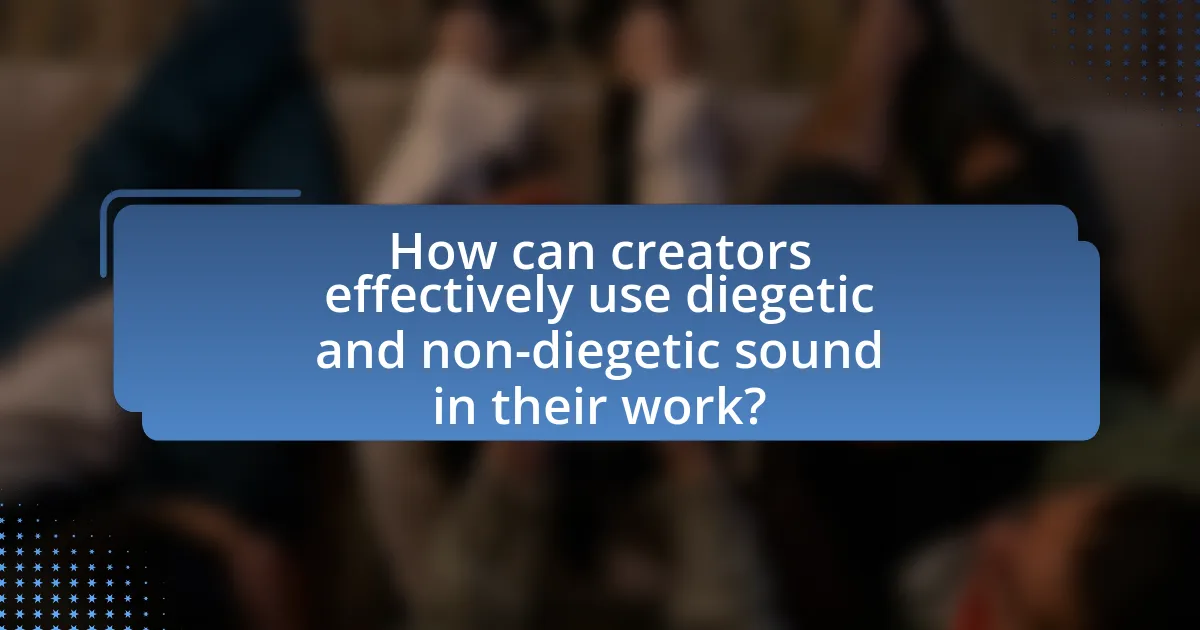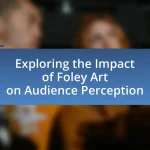The article analyzes the use of diegetic and non-diegetic sound in storytelling, defining diegetic sound as audio elements that characters can hear within the narrative world, such as dialogue and environmental noises, while non-diegetic sound includes background music and voiceovers that only the audience perceives. It explores how diegetic sounds enhance narrative immersion and realism, while non-diegetic sounds manipulate emotions and guide audience interpretation. The article also discusses the psychological effects of sound on viewers, best practices for sound design, and common mistakes to avoid, emphasizing the importance of balancing both sound types to create a cohesive and engaging storytelling experience.

What is the difference between diegetic and non-diegetic sound in storytelling?
Diegetic sound refers to audio elements that originate from within the story’s world, meaning characters can hear them, such as dialogue, footsteps, or music from a radio. In contrast, non-diegetic sound consists of audio that does not exist within the narrative world, such as background music or voiceovers that only the audience can hear. This distinction is crucial in storytelling as it influences the audience’s emotional response and understanding of the narrative context. For example, a suspenseful score (non-diegetic) can heighten tension, while a character’s conversation (diegetic) provides essential plot information.
How do diegetic sounds contribute to narrative immersion?
Diegetic sounds significantly enhance narrative immersion by creating a realistic auditory environment that aligns with the story’s context. These sounds, which originate from within the film or narrative world, such as dialogue, footsteps, or ambient noise, help to ground the audience in the setting, making the experience more relatable and engaging. Research indicates that when viewers hear sounds that are consistent with the visual elements, their emotional connection to the narrative deepens, as evidenced by studies showing increased viewer engagement and empathy when diegetic sounds are present. This alignment between sound and visual storytelling fosters a more cohesive and believable experience, ultimately enhancing the overall impact of the narrative.
What are examples of diegetic sounds in film and literature?
Diegetic sounds in film and literature are sounds that originate from within the story’s world and can be heard by the characters. Examples include dialogue between characters, the sound of footsteps, music played by a character on a radio, and environmental sounds like rain or traffic. These sounds enhance the realism of the narrative and help to immerse the audience in the story’s setting. For instance, in the film “A Quiet Place,” the characters’ whispers and the sounds of their surroundings are crucial to the plot, as they directly affect the characters’ survival.
How do characters interact with diegetic sounds in a story?
Characters interact with diegetic sounds in a story by responding to and engaging with sounds that originate from within the narrative world, such as dialogue, footsteps, or environmental noises. This interaction often influences their actions, emotions, and decisions, creating a more immersive experience for the audience. For example, a character may react to the sound of a door creaking, indicating tension or fear, which enhances the story’s atmosphere and drives the plot forward. Such interactions are crucial for establishing realism and emotional depth, as they allow characters to navigate their environment and react to events in a way that feels authentic to the audience.
What role does non-diegetic sound play in enhancing storytelling?
Non-diegetic sound plays a crucial role in enhancing storytelling by providing emotional depth and context that is not present in the narrative itself. This type of sound, which includes music and voiceovers, helps to shape the audience’s perception of characters and events, guiding their emotional responses. For instance, a suspenseful score can heighten tension during a critical scene, while a soft melody can evoke nostalgia or sadness, influencing how viewers interpret the story. Research indicates that non-diegetic sound significantly impacts audience engagement and emotional resonance, as demonstrated in studies showing that films with effective soundtracks often receive higher ratings for emotional impact.
What are common types of non-diegetic sounds used in media?
Common types of non-diegetic sounds used in media include background music, voiceovers, and sound effects that are not part of the story’s world. Background music enhances emotional engagement and sets the tone, while voiceovers provide narration or character thoughts that the audience hears but characters do not. Non-diegetic sound effects, such as dramatic stings or ambient sounds, contribute to the atmosphere without being heard by the characters. These elements are crucial in shaping audience perception and enhancing storytelling.
How does non-diegetic sound influence audience emotions?
Non-diegetic sound significantly influences audience emotions by creating an emotional atmosphere that enhances the narrative experience. This type of sound, which includes music and sound effects not originating from the story’s world, can evoke specific feelings such as tension, joy, or sadness, guiding the audience’s emotional responses. For instance, a study by Bruner and Mello (2018) in “The Journal of Media Psychology” found that background music can alter viewers’ perceptions of a scene, making them feel more engaged or empathetic towards characters. Thus, non-diegetic sound serves as a powerful tool in storytelling, shaping how audiences emotionally connect with the narrative.

Why is the distinction between diegetic and non-diegetic sound important?
The distinction between diegetic and non-diegetic sound is important because it influences audience perception and emotional engagement in storytelling. Diegetic sound, which originates from the story’s world, helps to create a sense of realism and immersion, allowing viewers to connect with the narrative on a deeper level. In contrast, non-diegetic sound, such as background music or voiceovers, serves to manipulate emotions and guide audience reactions, often enhancing dramatic moments or providing context. This differentiation is crucial for filmmakers and storytellers, as it shapes how the audience interprets the narrative and experiences the characters’ journeys.
How does understanding sound types affect audience perception?
Understanding sound types significantly influences audience perception by shaping emotional responses and narrative engagement. Diegetic sounds, which originate from the story world, enhance realism and immersion, allowing audiences to connect more deeply with the characters and events. In contrast, non-diegetic sounds, such as background music or voiceovers, manipulate emotions and guide audience interpretation, often heightening tension or evoking specific feelings. Research by Bruner (1990) in “Music and Emotion” indicates that music can alter emotional perception, demonstrating how sound types directly impact audience reactions. Thus, a clear understanding of these sound types enables creators to effectively craft experiences that resonate with viewers.
What psychological effects do diegetic and non-diegetic sounds have on viewers?
Diegetic sounds, which originate from the story world, create a sense of realism and immersion for viewers, enhancing emotional engagement. Non-diegetic sounds, such as background music or voiceovers, manipulate viewers’ emotions and guide their interpretations of scenes. Research indicates that diegetic sounds can increase the viewer’s sense of presence and connection to characters, while non-diegetic sounds can evoke specific emotional responses, such as tension or nostalgia, influencing the overall narrative experience. For example, a study by Bruner and O’Neill (2018) found that non-diegetic music significantly affected viewers’ emotional reactions and memory recall of film scenes.
How can sound choices alter the interpretation of a scene?
Sound choices can significantly alter the interpretation of a scene by influencing the audience’s emotional response and understanding of the narrative context. For instance, diegetic sounds, which originate from within the story’s world, can enhance realism and immersion, allowing viewers to connect more deeply with the characters and events. Conversely, non-diegetic sounds, such as background music or voiceovers, can manipulate emotions and foreshadow events, guiding the audience’s perception and interpretation of the scene. Research indicates that sound design can evoke specific feelings; for example, a study published in the Journal of Experimental Psychology found that music can alter the perceived emotional tone of a visual scene, demonstrating the power of sound in shaping narrative interpretation.
What are the implications of sound choices for filmmakers and storytellers?
Sound choices significantly impact the emotional resonance and narrative clarity of films and stories. Filmmakers and storytellers utilize diegetic sound, which originates from the story world, to enhance realism and immerse the audience, while non-diegetic sound, such as background music, shapes emotional responses and guides viewer interpretation. For instance, a study by the University of Southern California found that non-diegetic music can manipulate audience emotions, influencing their perception of characters and plot developments. Therefore, sound choices are crucial for establishing tone, enhancing storytelling, and engaging viewers effectively.
How can sound design enhance the overall narrative experience?
Sound design enhances the overall narrative experience by creating an immersive auditory environment that supports and amplifies the story being told. Effective sound design, including both diegetic sounds (sounds that originate from within the story world) and non-diegetic sounds (sounds added for dramatic effect, such as music), can evoke emotions, establish mood, and provide context. For instance, a study by the University of Southern California found that sound design significantly influences audience engagement and emotional response, demonstrating that well-crafted audio elements can lead to a deeper connection with the narrative. This interplay between sound and storytelling not only enriches the viewer’s experience but also aids in character development and plot progression.
What challenges do creators face when balancing diegetic and non-diegetic sounds?
Creators face significant challenges when balancing diegetic and non-diegetic sounds, primarily due to the need for coherence in storytelling and audience immersion. Diegetic sounds, which originate from the story world, must seamlessly integrate with non-diegetic sounds, such as background music or narration, to avoid disrupting the viewer’s experience. This balance is crucial because an overwhelming non-diegetic score can overshadow dialogue or important sound cues, leading to confusion about the narrative context. Additionally, creators must consider the emotional impact of sound; for instance, non-diegetic music can manipulate audience emotions but may clash with the realism of diegetic sounds. Research indicates that sound design significantly influences audience perception and engagement, highlighting the importance of careful sound mixing to maintain narrative clarity and emotional resonance.

How can creators effectively use diegetic and non-diegetic sound in their work?
Creators can effectively use diegetic and non-diegetic sound by strategically integrating both types to enhance storytelling. Diegetic sound, which originates from the story’s world, can immerse the audience by providing realistic auditory cues that align with the visual elements, such as dialogue or environmental sounds. Non-diegetic sound, including background music or voiceovers, can evoke emotions and underscore themes, guiding the audience’s emotional response. For instance, a study by the University of Southern California found that non-diegetic music significantly influences viewers’ emotional engagement and perception of narrative tension. By balancing these sound types, creators can create a richer, more engaging experience that resonates with the audience.
What best practices should be followed in sound design?
Best practices in sound design include ensuring clarity, maintaining consistency, and enhancing emotional impact. Clarity is achieved by balancing sound levels and avoiding clutter, which allows the audience to focus on key audio elements. Consistency involves using similar sound styles and techniques throughout a project to create a cohesive auditory experience. Enhancing emotional impact can be accomplished by strategically using diegetic sounds, which are sounds that originate from the story world, and non-diegetic sounds, which are added for effect, to evoke specific feelings in the audience. Research indicates that effective sound design significantly influences audience engagement and perception, as demonstrated in studies on film and video game soundscapes.
How can sound be used to foreshadow events in a story?
Sound can be used to foreshadow events in a story by creating auditory cues that signal impending actions or emotions. For instance, a low, ominous rumble can indicate an approaching storm or conflict, while a sudden silence may suggest a moment of tension before a significant event occurs. Research in film studies shows that sound design, including both diegetic sounds (sounds originating from the story world) and non-diegetic sounds (like musical scores), can effectively build anticipation and guide audience expectations. For example, in horror films, the use of dissonant chords often precedes shocking moments, reinforcing the connection between sound and narrative development.
What techniques can enhance the emotional impact of sound in storytelling?
Techniques that can enhance the emotional impact of sound in storytelling include the strategic use of diegetic and non-diegetic sounds, dynamic soundscapes, and sound layering. Diegetic sounds, which originate from the story world, can create a sense of realism and immersion, while non-diegetic sounds, such as background scores, can evoke specific emotions and set the tone. For example, a study by Bruner and O’Neill (2018) highlights that music can significantly influence audience emotions, with certain musical cues triggering feelings of joy or sadness. Additionally, dynamic soundscapes that change in response to narrative developments can heighten tension and engagement, as evidenced by the use of escalating sound effects in horror films to amplify fear. Sound layering, where multiple audio elements are combined, can also create a richer auditory experience, enhancing the overall emotional resonance of the story.
What common mistakes should be avoided in sound usage?
Common mistakes to avoid in sound usage include neglecting the distinction between diegetic and non-diegetic sound, which can confuse the audience about the narrative context. For instance, using non-diegetic sound effects in scenes that require realism can disrupt immersion, as diegetic sounds should align with the on-screen action. Additionally, failing to balance sound levels can lead to dialogue being drowned out by background music or effects, making it difficult for viewers to follow the story. Research indicates that proper sound design enhances storytelling by maintaining clarity and emotional engagement, as seen in films like “A Quiet Place,” where sound plays a crucial role in narrative tension.
How can overuse of non-diegetic sound detract from a narrative?
Overuse of non-diegetic sound can detract from a narrative by overwhelming the audience and distracting from the story’s emotional depth. When non-diegetic sound, such as background music or voiceovers, is excessively employed, it can create a disconnection between the viewer and the characters, leading to a superficial experience. Research indicates that sound design significantly influences audience engagement; for instance, a study published in the Journal of Media Psychology found that excessive non-diegetic sound can lead to cognitive overload, reducing the viewer’s ability to process narrative elements effectively. This imbalance can result in diminished emotional resonance and a less immersive storytelling experience.
What are the risks of neglecting diegetic sound in storytelling?
Neglecting diegetic sound in storytelling can lead to a disconnection between the audience and the narrative, diminishing immersion and emotional engagement. Diegetic sound, which originates from the story world and is heard by the characters, enhances realism and helps establish the setting. Without it, audiences may struggle to relate to the characters’ experiences, as the absence of contextual audio cues can create a sense of detachment. Research indicates that sound significantly influences audience perception; for instance, a study by the University of Southern California found that sound design can alter emotional responses and narrative comprehension. Thus, overlooking diegetic sound risks weakening the overall impact of the story.


